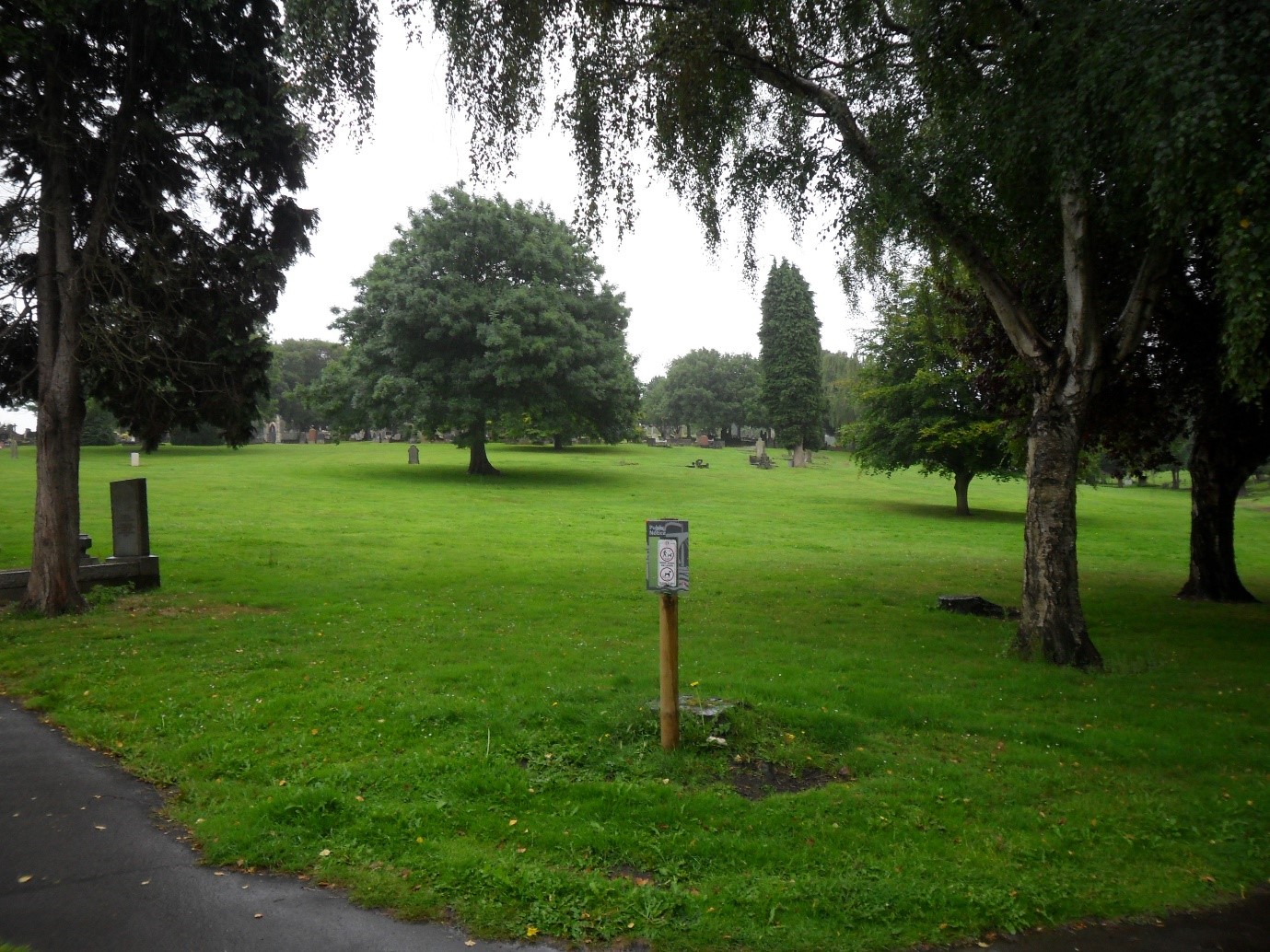
Introduction
From 2014-2019 Eastville Workhouse Memorial Group (EWMG) studied Rosemary Green, a piece of land consecrated and used as a pauper burial ground soon after the new workhouse was built at 100 Fishponds Road in 1847. Eastville workhouse was the primary institution of the Clifton Poor Law Union which covered 12 parishes north of the River Avon outside the old city walls. In March 1877 the Clifton Poor Law Union was renamed as Barton Regis. The Union remained unchanged until 1898 when several of its parishes were incorporated into the Bristol (city) Poor Law Union along with Eastville workhouse. Barton Regis Poor Law Union was finally abolished in 1904.[ 1 ]
In 2015 BRHG published data on all the people who were buried in Rosemary Green (4,084) and in 1972 crudely disinterred to common graves in Avonview cemetery in St George. We included people whose bodies were taken for medical research. It was these forgotten people we remembered on the memorial stones at Rosemary Green and Avonview cemetery. We did not record people whose bodies were listed in the death registers as “taken away by friends” as we assumed they would have had a burial in one of the parishes of the Clifton/Barton Regis Poor Law Union.
By November 1895, after nearly a half century of ‘packing and stacking’ bodies, Rosemary Green burial ground was full. The workhouse records state at this point the Guardians switched to the nearby Ridgeway Park Cemetery next to Eastville Park. However, that too filled up fairly rapidly and was only used for pauper burials for 11 years. In the intervening years, the Barton Regis Poor Law Union was abolished, the parishes and workhouse came under control of the Bristol (city) board of Guardians. On February 23rd 1906 the first burial of a pauper associated with Eastville workhouse took place in Greenbank cemetery. By April, pauper burials had ceased at Ridgeway cemetery.
The ‘Union Gate’
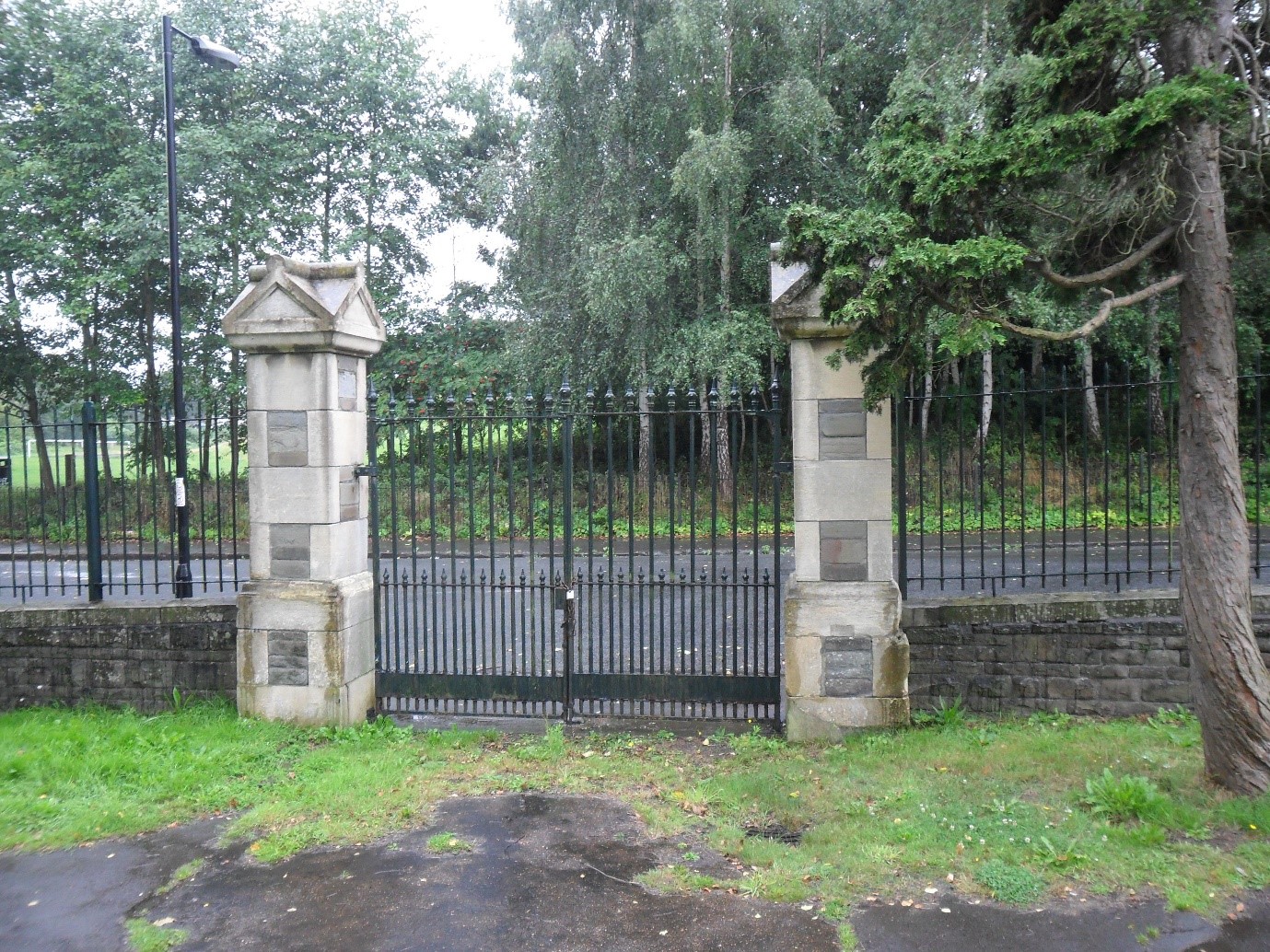
The stone gate in Greenbank cemetery at the lower end of Greenbank View, opposite the entrance to Rosemary Green, provided some of the first evidence that pauper burials were taking place in this public cemetery. This entrance is marked on Greenbank cemetery maps as the ‘Union Gate’, which is almost certainly a reference to the Poor Law Union and its workhouse just across Greenbank View. It appears to have been constructed sometime between 1903 and 1921, though the Union Gate was not built for the living but for the passage of the dead. Bodies from the nearby workhouse hospital buildings (blue in the figure) could be moved fairly easily by hand across the top end of Rosemary Green (green) and through the Union gate (red) to the mortuary buildings (black) in the cemetery.[ 2 ] With average death rates ranging from 2-4 per week in Eastville workhouse alone in the late nineteenth century, the gate would have been in constant use.[ 3 ]
In the summer of 2016, one of the research team visited the office in Greenbank cemetery (the old Mortuary building), with the late, lamented local historian and artist Mike Baker. Julian, a cemetery worker, pointed out the evidently drier coffin shaped patches on the hill going down to Greenbank view and showed us the large plan with the pauper’s graves marked in a different colour. It was now becoming clear that our public cemetery, Greenbank, was operating on the same lines as Rosemary Green, as a repository for unmarked pauper burials.
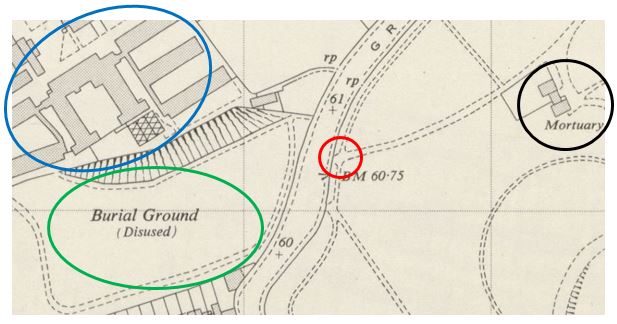
The new research
This was the background to a new phase of research launched in 2021. Two of our members, living locally, were also involved with the Friends of Greenbank cemetery Facebook group. This group along with Bristol and Avon Family Historians had recorded the names and dates of death of people interred at Greenbank. Thanks to help from Bristol Archives who provided high resolution images of the Poor Law Union death registers we have been able to add to this work. We transcribed the names and dates of death and other details from death registers and then cross referred to the cemetery records which determined those who were buried in the unmarked Greenbank burials.
We have found the usual sad and interesting cases – such as a boy drowned in the river and a two-year-old who was buried without a name after being left in the porch of Holy Cross Church. There were a huge number of babies who died in and out of the workhouse providing evidence that although life expectancy was increasing in the late nineteenth and early twentieth century, mortality rates remained stubbornly high amongst the very young.[ 4 ]
One inmate, Elizabeth Petherick, who died on 15th March 1907 had ‘med school’ written in pencil in the Greenbank register, suggesting she (or parts of her body) had been taken for dissection at a medical school. This is backed up by fact that there were two burial dates for her, March 21st 1907 and a second one seven months later on October 10th! It appears that some of her remains were buried at the later date. This example confirms that the practice of ‘giving’ (or selling) bodies to medical schools which had officially begun in Eastville Workhouse in 1872 continued into the twentieth century.[ 5 ]
Throughout the records we noted that, from time to time, some people were being buried at Arnos Vale cemetery in south Bristol. Interestingly, there is one exception in the records which delineates a burial at Arnos Vale as being ‘CoE’ (Church of England). There is a section of Arnos Vale cemetery called ‘Holy Soul’s’ which is where several of the inmates with Irish sounding names were buried. The noting of an exception implies that the those sent to Arnos Vale cemetery were not Church of England and might have mainly been Roman Catholics. A number of these names look of Irish origin, which would support this view.
We were also intrigued by the large number of men who died at 76 Milk Street (today, part of Cabot Circus shopping centre). We recently discovered that it was once a hostel that was opened by the Salvation Army to house around 40 destitute women, although we’re not sure in what year it converted to house men; we are hoping the Salvation Army still have records of this. Gloucester Lane off Old Market Street is another ominous address where lots of deaths occur. References in the death registers to Pullin’s and Rowe’s Lodging Houses, help explain why so many deceased paupers came from Gloucester Lane.
The workhouse historian Peter Higginbotham explained to us that if someone was in an unmarked grave it didn’t mean they were necessarily receiving poor relief. Unmarked (or ‘public’) graves were used for people who couldn’t (or whose family couldn’t) pay the costs of a ‘proper’ funeral and burial. In such cases, the address in the Poor Law Union death register would be listed a private house.
Signs of change…
The change from the majority of pauper burials being associated with Eastville workhouse pre-World War One to homes, hostels and lodging houses after the war is a reflection of political and economic developments. These are marked by the beginning of the welfare system in 1911, as a result of a massive strike wave, and the gradual phasing out of the workhouse which became statutory in 1929 with the abolition of the Poor Law Unions.
Better economic conditions for the working class may also be reflected by the number of pauper bodies recovered by their relatives and/or friends for burial. These are marked as ‘taken by friends’ in the Register of Deaths and there are significant differences between the Victorian, Edwardian and post-World War One periods. In our survey of burials at Rosemary Green in the Victorian period we estimated that around 1 in 5 pauper bodies were recovered, that is someone other than the Poor Law Union were able to pay for a funeral and burial. By the Edwardian period this ratio had reversed with more than half of the bodies being recovered.[ 6 ]
A clue to the changes in the nature of the Poor Law Unions and their workhouses can also be seen in the evolving names for the workhouse. Prior to World War One the death registers are entitled ‘Eastville Workhouse’ but at some point after 1907 it is renamed as the ‘Eastville Institution’ (see figures below). This concurs with a comment made by a correspondent to the Western daily Press (formerly a registrar of births, deaths and marriages) who claimed that around 1912:
all Boards of Guardians were instructed to give an alternative name to Poor Law Institutions under their care…to avoid stigma when births or deaths were registered that had taken place in such buildings.[ 7 ]
Finally, as part of the 1948 welfare reforms it appears it was renamed once again, as ‘100 Fishponds Road’.
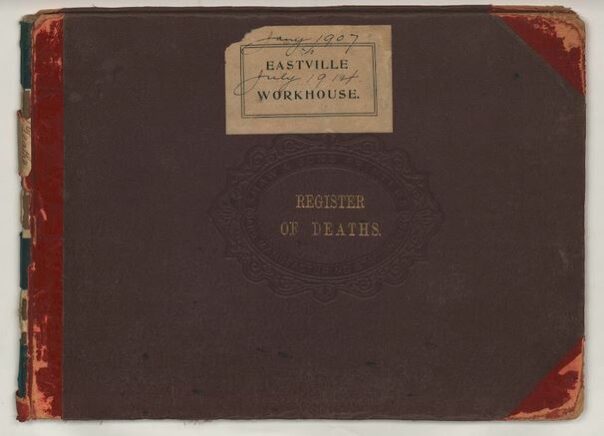
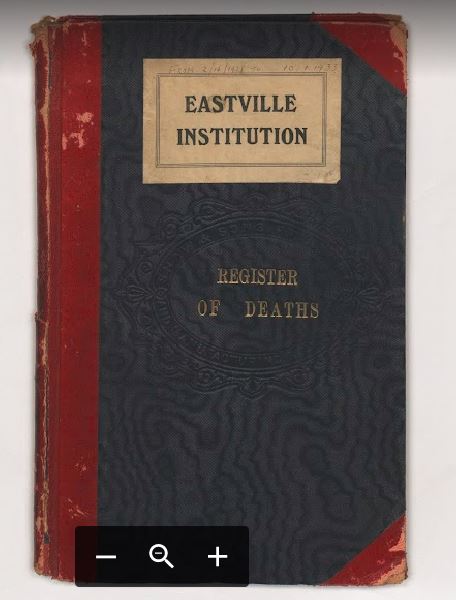
Why this is work important?
In 2015, over a few days, more than 3,000 people in Bristol downloaded the newly released data on the forgotten paupers buried in Rosemary Green. Since than many more people researching their family history have discovered ancestral relatives who were inmates of Eastville workhouse and were buried at Rosemary Green. We have had correspondence with people not just in the UK and Ireland but as far away as Canada and Australia.
There was huge support and praise for this community history project as it not only helped people find the forgotten but exposed the discriminatory treatment of the poor in life and death in Victorian times and more recently. It also brought to light the estimated million or more unmarked graves in the UK from the period after the 1834 Poor Law Amendment Act.[ 8 ] Many of these unmarked burials lie in public cemeteries without recognition, some of which are still in operation today. Our current project is aimed at exposing this fact in our local cemetery, Greenbank, and then encouraging others to research their local cemeteries. We believe unmarked Poor Law burials must be recognised, made public and physically memorialised for the true nature of this country’s history to be made visible and properly understood by future generations.
What period does the new data cover?
The latest data transcribed from the Poor Law Union death registers covers burials in Greenbank cemetery and a few in Arnos Vale. The periods of coverage are listed below:
April 1906 – July 1914 [Bristol Archives refs: 30105-2; 30105-3-5]
Jan 1924 – Sep 1928 [Bristol Archives refs: 30105-3-6]
Unfortunately, the Registers of Deaths for Eastville Workhouse for 1914-1924 do not appear to exist in the archives. The data on the period between the end of the burials in Rosemary Green (1895) and beginning of the burials in Greenbank cemetery (1906) which were interments in the Ridgeway Park cemetery are yet to be transcribed.
When is the data going to be released?
We are aiming to release the data as a series of searchable pdfs on the Bristol Radical History Group website over the next few months. If you would like to get involved in this project, please contact BRHG at brh@brh.org.uk. You can get regular updates here.
Acknowledgements
We would like to thank the staff at Bristol Archives, particularly Matt Coles and David Emeney for their help with this research. We would also like to recognise the work of artist, craftsman and historian Mike Baker who sadly passed away last year and aptly was the last person to be buried in Greenbank cemetery. Mike’s plaque marking the workhouse can be found on the old workhouse gate posts on the pedestrian entrance to East Trees Health Centre at 100 Fishponds Road.
Gloria Davey, Di Parkin, Trish Mensah, Roger Ball – Bristol Radical History Group – December 2021
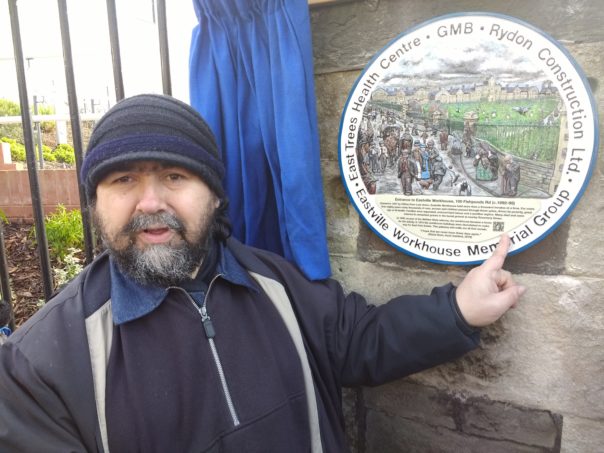
- [ 1 ] Ball, R. Parkin, D. and Mills, S. 100 Fishponds Rd: Life and Death in a Victorian Workhouse Third edtn. (Bristol: BRHG, 2020) pp. 29-30, 57-58. [back…]
- [ 2 ] See Know Your Place: Bristol. Retrieved from: https://maps.bristol.gov.uk/kyp/?edition= [back…]
- [ 3 ] See Rosemary Green burial data: https://www.brh.org.uk/site/wp-content/uploads/2015/01/workhouse-data-1890-95-VRS-2-0.pdf. [back…]
- [ 4 ] Ball et al. 100 Fishponds Rd p. 191. [back…]
- [ 5 ] Ibid. p.172. [back…]
- [ 6 ] Estimate based on sample from 1909; of the 307 deaths, 174 of the bodies (57 per cent) were ‘taken by friends’. Bristol Archives Ref. 30105-3-5. [back…]
- [ 7 ] Western Daily Press 14 July 1948. [back…]
- [ 8 ] Ball et al. 100 Fishponds Rd p. 3. [back…]





I am presently attempting to repair greenbank mortuary.
There is a coffin inside belonging to baby J.
Police were contacted by community members and pc varghese is investigating why it is in the mortuary chapel and not interred.
The council suggested the chapel is too expensive to fix and the roof is falling in.
Yesterday 2 steeple jacks arrived and will be fixing the roof as soon as poss.
Locals are passionate about using the mortuary chapel for community activities and even want to dig up an area to make a pond believing the cemetery to be an excellent community resource and conservation area.
I say its a cemetery that is still burying people in their “final resting place” and
families and friends are freshly bereaved surrounded by locals using the place 4 birthday paties and filming death metal demonic growling songs beside newly interred young mums.
Im told by conservationists passing through that they would love a wild woodland type burial and letting greenbank go wild is great.
I say greenbank is a wealthy victorian cemetery and those buried at this grave yard chose posh not hippy graves..
Or came from the workhouse if they were lucky and got vanished into the cemetery or medical school in unmarked graves so….
Take your woodland burial and digging up the dead to make ponds to the WOODS…
but thats me
I like the dead to stay dead
And
Buried
And not dug up and relocated or covered over by brambles and turned into ponds
Hi i am trying to find the grave for an uncle who died as a child in 1938 and was buried in another persons grave on the condition there was no marking of his name on the stone. The burial took place on the 15th January 1938. I have some details but would welcome any help in locating the grave .
Apologies should add the grave is at Greenbank cemetery Bristol
Am wandering if you can locate the burial of a Henry George Rique apparently buried in a paupers grave in Greenbank Cemetery in March 1939
The person you are looking for is my grandfather.
I’ve also looked for him there he’s my great grandfather on mothers side, can I ask who you are?
Sorry, I was wrong Henry Sr is buried at Greenbank.
Henry George Rique junior is buried there.
Do you know where abouts he is, he’s my great grandfather I found a rectangular slab by the wooded exit out onto rotate hill not 100% if that’s where he was